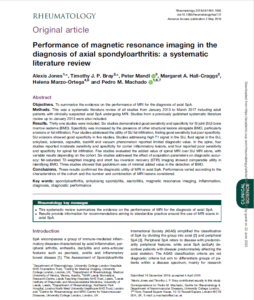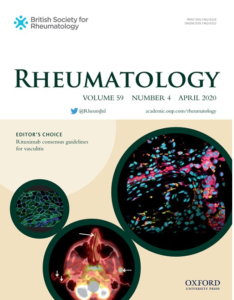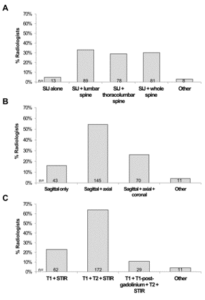
READ HERE
Recommendations for acquisition and interpretation of MRI of the spine and sacroiliac joints in the diagnosis of axial spondyloarthritis in the UK.
Bray TJP, Jones A, Bennett AN, Conaghan PG, Grainger A, Hodgson R, et al. Recommendations for acquisition and interpretation of MRI of the spine and sacroiliac joints in the diagnosis of axial spondyloarthritis in the UK. Rheumatology (Oxford). 2019;58(10):1831-8. https://doi.org/10.1093/rheumatology/kez173
A working group comprising nine rheumatologists and nine musculoskeletal radiologists with an interest in axial SpA was established, with support from BRITSpA. Two meetings were held. In the first meeting, research questions were formulated. In the second meeting, the results of a systematic literature review designed to inform the recommendations were reviewed. An anonymized Delphi process was used to formulate the final set of recommendations. Two overarching principles were formulated, as follows: The diagnosis of axial SpA is based on clinical, laboratory and imaging features (overarching principle 1), and patients with axial SpA can have isolated inflammation of either the sacroiliac joints or the spine (overarching principle 2). Seven recommendations addressing the use of MRI in the assessment of patients with suspected axial SpA were formulated (see table below), covering topics including recommended sequences, anatomical coverage, acquisition parameters and interpretation of active and structural MRI lesions. The level of agreement for each recommendation was very high (range 8.8–9.8). A joint rheumatology and radiology consensus on the acquisition and interpretation of MRI in axial SpA diagnosis was achieved, and a research agenda formulated. This consensus should help standardize practice around MRI and ensure a more informed, consistent approach to the diagnosis of axial SpA.
| Rec1 |
When requesting an MRI for suspected axial SpA, imaging of both the SIJs and the spine is recommended |
| Rec2 |
T1-weighted and fat-suppressed, fluid-sensitive sequences (including STIR, fat-saturated T2 or Dixon methods) are recommended for suspected axial SpA |
| Rec3 |
The minimum protocol when requesting an MRI for suspected axial SpA should include sagittal images of the spine with extended lateral coverage and images of the SIJs that are in an oblique coronal plane to the joint |
| Rec4 |
In the SIJs, the presence of bone marrow oedema, fatty infiltration or erosion is suggestive of the diagnosis of axial SpA. The presence of more than one of these features increases the diagnostic confidence of axial SpA |
| Rec5 |
In the spine, the presence of multiple corner inflammatory lesions and/or multiple corner fatty lesions increases the diagnostic confidence of axial SpA |
| Rec6 |
In the SIJs and/or spine the presence of characteristic new bone formation increases the diagnostic confidence of axial SpA |
| Rec7 |
The full range and combination of active and structural lesions of the SIJs and spine should be taken into account when deciding if the MRI scan is suggestive of axial SpA or not |



